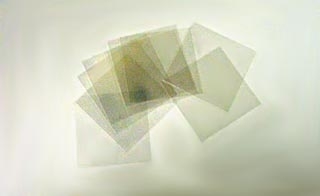ITO Coated Cover Slips, 20 x20 mm Thickness #1.5, 8-12 Ohms Resistivity, Pk100 with Busbar
SPI Supplies® Brand ITO Coated Cover Slips
Thickness #1.5 (0.16 to 0.19 mm thick)
Glass
Busbar
Pack of 100 cover slips
20 x 20 mm
Resistivities: 8-12 ohms
The concept behind the use of indium-tin-oxide (ITO) coated microscope cover slips, as it is for ITO coated slides, is surprisingly simple: Take a glass cover slip, coat it with ITO, apply a suitable conductor strip at the ends, connect electrical leads (to put a voltage potential across the slide) and the cover slip will be uniformly heated, higher even than the boiling point of water (if desired). High transparency (from UV to NIR) ITO coatings have applications not only for microscopy but any time planar, electrically conductive surfaces are required that have the just indicated transparency. Our coatings are also used by researchers in the areas of liquid crystal display technology, polymer light emitting diode technology and related applications. We offer ITO coated cover slips in four different standard ITO coating thicknesses.
No SiO2 passivation layers present!
While certain products used in research are seen by the typical user as being "generic", that all brands are "the same", let us assure you that this is not the case for ITO coatings. The SPI Supplies Brand of ITO coated substrates are most certainly not like any other. While we surely do want to protect our proprietary technology and know how, we do want to cite one important difference: The SPI Supplies® Brand ITO coatings are not applied over an SiO2 passivation layer and the absence of such a passivation layer can have important advantages to many users.
How can we get away with no passivation layer?
Because of the uniqueness of our process, one absolutely need not worry about the leaching of alkali oxides into liquid crystal systems, and therefore there is no need for a passivation layer. Our ability to avoid this costly step results in a lower cost production process and at the same time, results in an incremental increase in transmittance.
Cleaning your ITO-coated cover slips:
There may be times when the user would feel more comfortable giving the cover slip a cleaning treatment prior to use. The recommended cleaning solvent is isopropyl alcohol. This solvent should not injure the ITO coating but with prolonged contact, it could start to dissolve a bus-bar if present. Make sure the solvent used is spectroscopic purity because any organic residues will detract from the performance of the cover slip. The best way to be sure the cover slip is free of all organic contamination is to perform a plasma cleaning in the SPI Supplies Plasma Prep II plasma etcher. We would also recommend the use of a high quality lint-free cotton wiper such as our own SPI-Wipes™ Lint-Free Cotton Wipers.
A Note on Terminology:
The electrical properties of the ITO coating are given as resistivity, measured in ohms per square. To determine the actual resistance of a cover slip, it is necessary to do a short calculation. For example, if the resistivity is 30 to 60 ohms per square, then the resistance of the coating on a cover slip 25 x 75 mm, measured along the length, is 90 to 180 ohms. This is determined by dividing the length of the slide by the width of the slide, in our example dividing 3 by 1, or 75 by 25, and multiplying that result (3 in our example) by the resistivity. No matter what units you use to measure the dimensions, the resistance of the coating is the same.
Standard resistivities offered:
We have defined four standard resistivities. We run these four resistivities (e.g. ITO coating thickness) frequently and we are therefore able to insert custom runs for customers without charging the cost of a full run against a small quantity ordered. We can of course make any other resistivity, but the set up charges will be much higher. Therefore when specifying a custom coating resistivity, try to stick to one of the standard resistivities but if you can't, and some customers can not, then we can produce whatever resistivity that might be needed. However you will have to be prepared for the added cost associated with the non-standard resistivity.
Busbar vs. No Busbar:
Most traditional applications involved the passage of an electrical current through the ITO coating and that meant that one way or another, electrical leads would have to be applied to the cover slip at two opposite ends. On the other hand, some emerging applications do not require such electrical contacts. Yet others prefer to apply their own busbars. That is why we offer the product both with as well as without the burbars.
Caution:
Electrical resistance heating can expose you to potentially lethal voltages. We recommend that you use only low voltage power supplies for this application.

